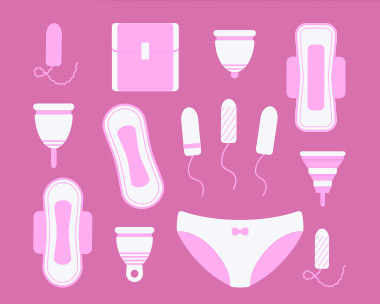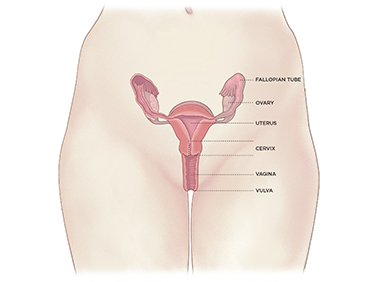As you wait for your first period, you may have lots of questions about what will happen. What will it feel like? What do I need to do to prepare? How do I use a tampon?
Getting your first period is an important milestone in a young woman’s life. It signals the beginning of a long phase of life (around 40 years!) that you may be fertile. This means that if you have sexual contact, you might get pregnant. While you may have learned about menstruation in school, you probably have questions about what to expect. This section is designed to provide you with all the information you need as you approach getting your period for the first time.
When should I expect my first period?
Most girls get their first period somewhere between the ages of 10 and 14, with an average of just over 12 years old. It’s hard to tell when your first period will arrive. It usually happens about two years after the first signs of puberty (usually breast development), and about a year after you begin growing pubic hair. You will also notice white or yellowish vaginal discharge in the few months leading up to your period.
There are numerous factors that are thought to influence the age of the first period, including:
- Nutrition
- Exercise
- Genetics
- Ethnicity
- Body size
- Geography (northern climates vs. southern climates)
- Family income, size, structure
- Parental education
- Illness and stress
The average age of the first period has been decreasing over time. In 1900 in the United States, the average age of the first period was between 14 and 15 years of age. The decreasing age of the onset of menstruation seems to have levelled off now at 12.

There is no way to predict exactly when you will get your first period, and there is nothing you can do to make it start, except wait. If you are worried about your first period, talk to your family doctor.
If you are sexually active, you will need to consider the possibility that you could get pregnant once you have your period. In fact, you can even get pregnant if you’ve never menstruated, since it’s possible to ovulate before your first period. There are many forms of birth control available – read about them here. You are also at risk of sexually transmitted infections if you are sexually active – learn how to protect yourself.

What do I need to do to prepare for my first period?
 There is nothing in particular you need to do to prepare for your first period, besides having feminine hygiene products and over-the-counter pain relievers such as ibuprofen or naproxen on hand. If you happen to get your period with no access to menstrual products, toilet paper will work in an emergency. If you get your first period at school, your teacher or school nurse will have a pantiliner or pad on hand.
There is nothing in particular you need to do to prepare for your first period, besides having feminine hygiene products and over-the-counter pain relievers such as ibuprofen or naproxen on hand. If you happen to get your period with no access to menstrual products, toilet paper will work in an emergency. If you get your first period at school, your teacher or school nurse will have a pantiliner or pad on hand.
There are a variety of menstrual products available to you:
Disposable pads
These absorbent pads have an adhesive backing that sticks to the inside of your underwear. They are available in different lengths and absorbencies, and some have adhesive ‘wings’ that wrap around the sides of your underwear. Disposable pads should be changed every 4-6 hours and are thrown out after a single use.
Pantiliners
These are small, thin, disposable absorbent pads that can be used on their own on days of light flow. They can also be used in combination with a tampon, in case of leaks or discharge.
Reusable pads
These are usually made of cotton, bamboo, or other natural absorbent fibres, and are often available at health food stores. They can be washed with detergent and reused. Some have velcro tabs to secure them around your underwear.
Tampons
These are small, cylindrical plugs of disposable absorbent material (cotton and/or rayon) that are inserted into the vagina to absorb menstrual flow. Tampons have a string attached so that they can be pulled out. They come in a variety of sizes and absorbencies, and may come with an applicator or without. Tampons should be changed every 4-6 hours, and used tampons should be discarded.
Menstrual cup
This is a cup-shaped, flexible silicone or rubber apparatus that is inserted inside the vagina to catch menstrual flow. The cup has a stem on the bottom for removal. Menstrual cups should be emptied every 8-12 hours. Some are disposable and others can be washed and reinserted.
How do I use a pad?
Disposable pads have an adhesive backing. Peel off the paper that covers the sticky side, and adhere the pad to the inside of your underwear. Pads should be disposed of in the garbage, and not flushed down the toilet.
How do I use a tampon?

Inserting a tampon for the first time can be a bit of a challenge. It’s hard to know exactly how to position your body and at what angle to put the tampon in. After a few tries, you will figure out what works best for you. It’s best to use ‘slender’ size tampons when you are learning. If you aren’t exactly sure where your vaginal opening is, use a mirror to have a look at your vulva (the exterior part of your genitals – see diagram ).
To insert a tampon that has an applicator:
- Wash your hands with soap and water.
- Unwrap the tampon from its packaging and sit or stand in a comfortable position. Some women prefer to stand up and put one leg up on the toilet or tub, some prefer to remain sitting, or squat down.
- Hold the tampon with your thumb and middle finger at the top of the outer tube. Insert the tampon into the vaginal opening, aiming it at your lower back. Once the outer tube is inside your vagina, push the inner tube of the applicator with your index finger.
- Remove the applicator (both the inner and outer tube) from your vagina and make sure the string of the tampon is hanging outside of your vaginal opening.
- Wash your hands.
- Once you are ready to remove the tampon, pull the string downward.
- Tampons should be disposed of in the garbage, and not flushed down the toilet.
To insert a tampon without an applicator:
- Wash your hands with soap and water.
- Unwrap the tampon from its packaging and sit or stand in a comfortable position. Some women prefer to stand up and put one leg up on the toilet or tub, others prefer to remain sitting, or squat down.
- Find the dent in the tampon where the string is attached. Pull the string back and forth and around in a circle, to create a space for your finger. Hold the tampon with your thumb and middle finger. Using your index finger, push the tampon as high as you can into your vagina. Make sure the string is hanging outside of your vaginal opening.
- Wash your hands.
- Once you are ready to remove the tampon, pull the string downward.
- Tampons should be disposed of in the garbage, and not flushed down the toilet.
Once a tampon is inserted properly, you should not be able to feel it. If you can feel it, it means the tampon is not inserted high enough in your vagina. You can try pushing it higher with a clean index finger, or start with a fresh tampon. Tampons should be changed frequently – every 4-6 hours – to reduce the risk of developing Toxic Shock Syndrome (TSS). TSS is a rare, but very serious infection cause by a bacteria called Staphylococcus aureus. Symptoms included flu-like symptoms, high fever, dizziness, vomiting, rash, and diarrhea. If you have these symptoms while wearing a tampon, remove the tampon and contact your health care provider or visit the emergency room.
How do I choose a pad or tampon that is right for me?
There are smaller, slender pads and tampons available that young women often prefer, particularly when they first start menstruating. You may find it helpful to use different products over the course of your period, with more absorbent tampons or pads being used on heavier flow days, and smaller tampons or pantiliners on low flow days. Each woman has her own preferences and whatever works best for your body is just fine!
What will my first period feel like?
You may find your first period comes and goes with very little in the way of symptoms, or you may find you experience quite a bit of discomfort. Common symptoms include:
- Cramping in the lower abdomen
- Breast tenderness
- Lower backache
- Diarrhea or nausea
- Dizziness
Most of these symptoms do not last long, and can be treated with ibuprofen or other over-the-counter pain relief medications. A heating pad or hot water bottle on the abdomen or lower back can help ease pain in these areas. More details on menstrual pain and other symptoms can be found here .
How long will my first period last?
Your first period should last anywhere from 2 to 7 days. It may be very light, with just a few spots of brownish blood. Or it may start and end more brownish, but be brighter red on heavier flow days.
How do I know when I will get my next period?
It’s impossible to predict when your next period will start. Most girls and women go about 28 days from the first day of one period to the first day of the next, but anywhere from 21-35 days is normal. Especially in the first few years of menstruating, your period may be very irregular. If you track your period on a calendar (start day, number of days of bleeding, any symptoms), you will begin to notice a pattern over time. You can use this ‘menstrual diary‘ to keep track of your periods.
What if my period doesn’t come – or if it starts when I am very young?
If you have not had a first period by the age of 15, or it’s been more than two to three years since your breasts started developing and you have not had a period, it’s best to talk to your doctor. If you get your period very young, at nine or ten it is usually just simply that you developed early. However, it’s a good idea to see your doctor to rule out other underlying medical conditions.

